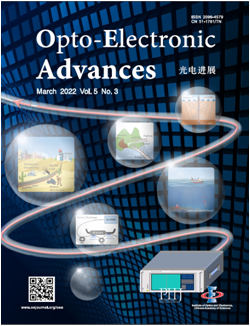2022 Vol. 5, No. 3
Cover story: Fraggelakis F, Tsibidis GD, Stratakis E. Ultrashort pulsed laser induced complex surface structures generated by tailoring the melt hydrodynamics. Opto-Electron Adv 5, 210052 (2022).
Nature provides an abundance of functional surfaces as a direct consequence of evolutionary pressure that forces them to demonstrate adaptation to environmental conditions and outstanding performance. Fabricated patterns of enhanced complexity of micro- and nanometer length scales can emulate the impressive bioinspired performance and functionalities in various applications fields in technology and life sciences. Direct Laser Interference Patterning (DLIP), a recently introduced laser-based fabrication methodology, has the capability to tailor the features of a surface topography and form a broad range of surface structures. Recently, Dr. Fotis Fraggelakis, Dr. George D. Tsibidis and Dr. Emmanuel Stratakis from the UNLMP Research Group at the Institute of Electronic Structure and Laser at FORTH-Hellas reported a novel approach for tailoring the laser induced surface topography upon femtosecond (fs) pulsed laser irradiation and the use of DLIP. Experiments and simulations presented in this report emphasized the capability to actively tailor the microfluidic melt motion that dominates the structure formation process, via controlling the applied temperature gradient’s temporal profile. The investigation indicated that combining Gaussian beams with DLIP in double pulse trains enables the generation of unique sub-micron surface topographies with increased complexity. This demonstrates an unparalleled capacity towards tailoring laser-induced morphology and obtaining complex topographies for a variety of applications.
Back cover story: Liu SQ, Yu FH, Hong R, Xu WJ, Shao LY et al. Advances in phase-sensitive optical time-domain reflectometry. Opto-Electron Adv 5, 200078 (2022).
Phase-sensitive optical time-domain reflectometry (Φ-OTDR) has attracted numerous attentions due to its superior performance in detecting the weak perturbations along the fiber. Relying on the ultra-sensitivity of light phase to optical fiber’s tiny deformation, Φ-OTDR has been treated as a powerful technique with a wide range of applications. Research groups led by Prof. Liyang Shao from Southern University of Science and Technology, and Prof. Feng Wang from Nanjing University, collaboratively reviewed the recent advancements in Φ-OTDR technology, covering theoretical research and practical applications. The operation principles of distributed vibration sensing (DVS) Φ-OTDR and distributed acoustic sensing (DAS) Φ-OTDR are discussed. For DAS Φ-OTDR, it is fundamental to accurately extract the phase of scattering lightwave for a quantitive analysis of external vibrations. Phase demodulation methods including heterodyne detection, I/Q demodulation, 3 by 3 coupler, phase generation carrier, etc., are introduced and compared. Various methods for enhancing the sensing performances of Φ-OTDR system are subsequently analyzed in detail, regarding the sensing distance, signal-to-noise ratio, spatial resolution, frequency response range, and vibration event discrimination ability. Furthermore, the practical implementations of Φ-OTDR under different scenarios are thoroughly reviewed, featuring the applications in geological explorations, perimeter security, transportation monitoring, and partial discharge detection. This review may serve as a roadmap for future improvements of Φ-OTDR operation principles, advanced data interpretation methods, and extending its application areas.

-
{{article.year}}, {{article.volume}}({{article.issue}}): {{article.fpage | processPage:article.lpage:6}}. doi: {{article.doi}}{{article.articleStateNameEn}}, Published online {{article.preferredDate | date:'dd MMMM yyyy'}}, doi: {{article.doi}}{{article.articleStateNameEn}}, Accepted Date {{article.acceptedDate | date:'dd MMMM yyyy'}}CSTR: {{article.cstr}}
-
{{article.year}}, {{article.volume}}({{article.issue}}): {{article.fpage | processPage:article.lpage:6}}. doi: {{article.doi}}{{article.articleStateNameEn}}, Published online {{article.preferredDate | date:'dd MMMM yyyy'}}, doi: {{article.doi}}{{article.articleStateNameEn}}, Accepted Date {{article.acceptedDate | date:'dd MMMM yyyy'}}CSTR: {{article.cstr}}

 E-mail Alert
E-mail Alert RSS
RSS



